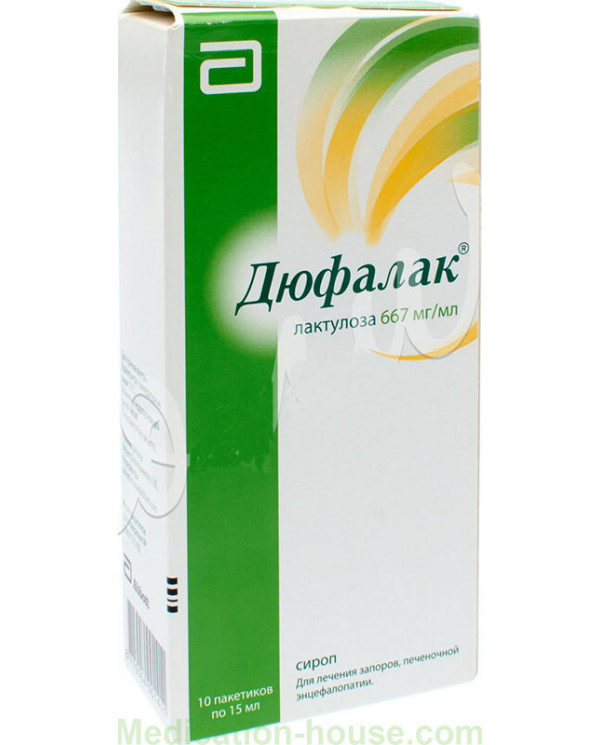Instruction for Duphalac
You can buy Duphalac here
One of the most effective treatments for constipation is considered lactulose. Due to its mechanism of action, proven effectiveness and high safety, drugs based on it are successfully used in the treatment of not only adult patients, but also children and pregnant women. In the market, Duphalac is the leader among all drugs with lactulose. We will consider in detail the instructions for the use of Duphalac Syrup for constipation in adult patients and children.
Composition and description
Duphalac is available in the form of a syrup, 100 ml of which contains 66.7 lactuloses.
The drug has the form of a viscous transparent liquid, from colorless to light yellow in color with a sweet taste.
Mechanism of action
The microflora of the large intestine breaks down lactulose into organic low molecular weight acids. This causes an increase in osmotic pressure and a decrease in pH, which, in turn, helps to increase the volume and soften feces, stimulate intestinal peristalsis. As a result of these processes, the natural mechanism of bowel movement is restored.
The therapeutic effect of Duphalac in hepatic encephalopathy is explained by the following effects of the drug:
promotes the growth of acidophilic microflora in the large intestine, which inhibit the activity of proteolytic bacteria;
shifts the hydrogen index to the acid side, which facilitates the conversion of ammonia molecules into ionic form;
makes the vital activity of the microbial flora of the intestine more active, using ammonia for protein synthesis;
increases osmotic pressure and thereby has a laxative effect, removing toxic products from the intestines.
According to doctors and patients, taking Duphalac and its analogues has a quick therapeutic effect with intestinal dysbiosis. This is because lactulose is a prebiotic, that is, a substance that enhances the growth of lactobacilli and bifidobacteria. They, in turn, inhibit the development of potentially pathogenic microflora, in particular, clostridia and Escherichia coli.
When taken orally, the drug is not absorbed into the systemic circulation and reaches the large intestine in an unchanged form, where it is split by intestinal microflora. When taken in a dose of more than 40–75 ml, Duphalac is partially excreted unchanged.
Indications for use
In accordance with the instructions, indications for the appointment of Duphalac are:
normalization of the physiological rhythm of defecation (treatment of constipation);
softening of the stool in a number of diseases (anal fissure, conditions after rectal surgery, hemorrhoids, acute myocardial infarction);
hepatic encephalopathy (the drug can be used both for the prevention and treatment of hepatic coma).
Contraindications
The main contraindications to the use of Duphalac are:
glucose galactose malabsorption;
lactase deficiency;
fructose or galactose intolerance;
increased individual sensitivity to the drug;
intestinal obstruction;
risk of perforation or perforation of the hollow organs of the gastrointestinal tract;
galactosemia.
With undiagnosed rectal bleeding, the presence of an ileostomy or colostomy, Duphalac should be used only in extreme cases and with great care.
Pregnancy and lactation
Lactulose is not absorbed into the bloodstream and does not have a systemic effect on the body. Therefore, the drug can be used during pregnancy and breastfeeding.
Dosage and administration
Duphalac is taken orally in undiluted or diluted form. The dose intended for one dose should be swallowed without delaying in the oral cavity.
It is advisable to take the medicine at the same time, with food or after eating.
During the course of treatment with laxatives, including lactulose, the patient should drink a sufficient amount of liquid (at least 6-8 glasses of water per day).
For the correct dosage of the drug, it is necessary to use the measuring cap attached to each bottle of the drug.
How much and how to take Duphalac in case of constipation
The daily dose of the drug should be taken once. In the treatment of elderly patients and children, its division into two doses is allowed.
The laxative effect usually develops 2-3 days after the start of treatment. Depending on the reaction of the body, the initial dosage may be changed by the attending physician.
Approximate doses of the drug recommended in the manufacturer's instructions:
Children of the first year of life - Not more than 5 ml;
Children from 1 year to 6 years - From 5 to 10 ml;
Children from 7 to 14 years old - 15 ml;
Adolescents over 15 years old and adults - From 15 to 45 ml.
Dosage for hepatic encephalopathy
The drug helps well in the complex treatment of hepatic encephalopathy. The initial dose for adults is 30-45 ml, this amount should be taken every 6-8 hours. In the future, they switch to a supporting individual dosage, which should provide soft stool no more than three times a day.
Children and adolescents Duphalac for the treatment of hepatic encephalopathy is not prescribed, since there is no data on the effectiveness and safety of such therapy in this category of patients.
Use in the elderly and patients with renal failure
Given that the systemic effect of lactulose on the body is negligible, dosage reduction is not required when prescribing Duphalac to patients with chronic renal failure and the elderly.
Side effect
The first few days of taking the drug, patients may experience flatulence (bloating). With the continuation of the course of treatment, this phenomenon goes away on its own.
When using large doses of Duphalac, patients may develop diarrhea, leading to the development of disturbances in the water-salt balance.
Overdose
When taking a large dose of the drug, the following symptoms may occur:
diarrhea;
abdominal pain;
nausea, vomiting.
Treatment consists in the complete withdrawal of the drug or a decrease in dosage. With severe vomiting and diarrhea, oral rehydration or infusion therapy may be required to eliminate water-salt balance disturbances.
Interaction with other drugs
There are currently no data on the interaction of lactulose with other drugs, since such studies have not been conducted.
Special instructions
If taking the drug for 2-3 days does not lead to the proper therapeutic effect, the patient should consult a doctor, as in this case, you may need to increase the dosage.
Duphalac contains a small amount of linked sugars:
fructose;
lactose;
epilactose;
galactose.
5 ml of Duphalac syrup contains 0.075 XE (bread units). This must be considered when prescribing the drug (especially in large doses) to patients suffering from diabetes.
Any laxatives, including those based on lactulose, in the treatment of children should be used only if there is evidence and as directed by the attending physician. During therapy, they may experience disorders of the colon emptying reflex.
The drug does not affect the ability to drive vehicles and perform work that requires an increased concentration of attention.
Storage conditions
The syrup is stored out of the reach of children, at a temperature not exceeding 25 ° C.
The shelf life of the drug is 3 years from the date of release. After the expiration date, it should not be taken.
Terms of sell
You don't need a prescription to buy Duphalac.



